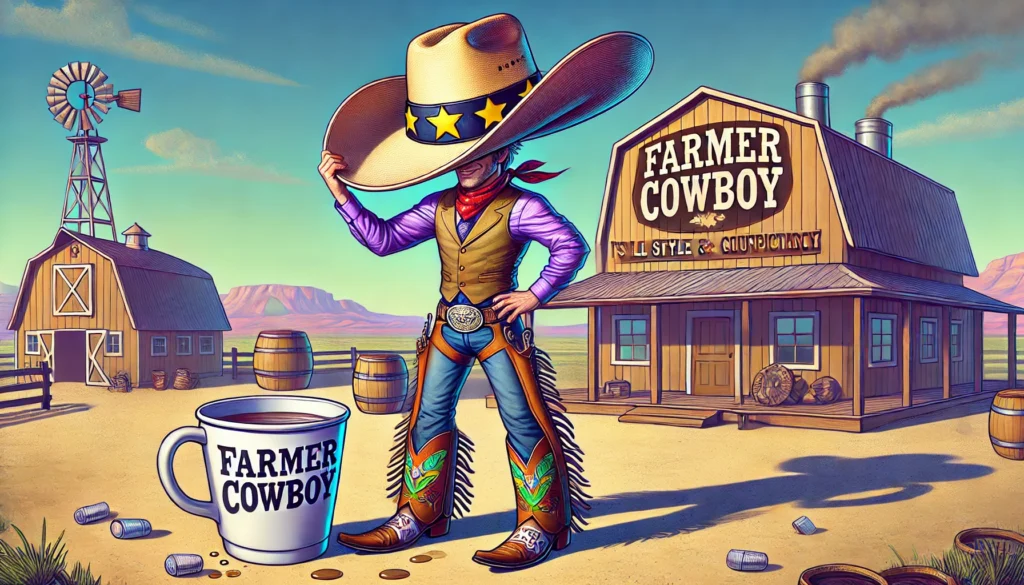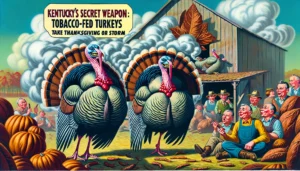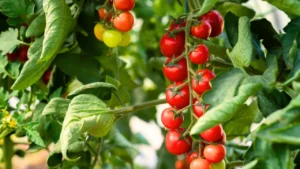
All Hat and No Cattle A satirical and humorous image in the style of farmercowboy.com branding. The scene shows a cowboy with a ridiculously oversized 10 gallon hat strugg1.webp.webp
All Hat and No Cattle: When Cowboy Swagger Falls Flat
Why Big Hats Don’t Always Mean Big Herds (Or Big Deeds)
Big Bluff, TX — In Big Bluff, Texas, where the cowboy culture runs as deep as the Lone Star pride, there’s a saying that cuts through the bravado like a sharp spur: “All hat and no cattle.” It’s a phrase that perfectly describes those folks who strut around town with the biggest hats and the loudest boots, but when it comes time to actually herd some cattle, they’re as lost as a steer in a snowstorm.
The Legend of Big Bluff’s Biggest Hat
Take, for example, the legend of Johnny “Big Hat” McGee, a man known for his oversized Stetson and even bigger tales. Johnny’s hat is the stuff of legend—wide-brimmed, sky-high, and adorned with enough silver conchos to blind a man in the midday sun. But for all the hat-wearing, Johnny’s ranch remains suspiciously empty.
“I remember the first time I saw Johnny’s hat,” said local rancher Buck Bristle. “I thought, ‘Now there’s a man with a serious cattle operation.’ Turns out, the only thing serious about Johnny is his commitment to looking the part.”

Eyewitness Accounts: The Hat, the Myth, the Legend
Johnny’s hat has become something of a spectacle in Big Bluff. Tourists flock to see it, snapping photos and asking him about his “vast” ranch. But the locals know the truth. “He’s all hat and no cattle,” said Jolene, the waitress at the Rusty Spur Saloon. “He’ll tell you he’s got thousands of head, but I’ve yet to see a single hoof.”
Even the local cattle seem unimpressed. One witness recalls a time when Johnny tried to show off his “herding skills” at the annual Big Bluff Rodeo. “He looked the part, alright,” said Hank “Grit” Sanders. “But when it came time to move those cattle, they just stared at him like he was speaking French. It was the most action that hat’s ever seen.”

Expert Insights: Why Some Cowboys Are All Hat and No Cattle
According to Dr. Dusty Spur, a professor of cowboy culture at Texas A&M, the phenomenon of “all hat and no cattle” is more common than you’d think. “In the world of ranching, image is everything,” Dr. Spur explained. “Some folks get so caught up in looking the part that they forget to actually live it. The hat becomes a symbol of what they wish they were, rather than who they really are.”
Dr. Spur’s research shows that the size of a cowboy’s hat is often inversely proportional to the size of his herd. “It’s a classic case of overcompensation,” she said. “The bigger the hat, the smaller the ranch—or sometimes, no ranch at all.”

Public Opinion: What Big Bluff Thinks of Johnny McGee
The citizens of Big Bluff have their own opinions about Johnny “Big Hat” McGee. Some see him as a harmless figure, a man who just enjoys dressing the part. “He’s not hurting anyone,” said Mabel, the town’s librarian. “If wearing a big hat makes him happy, who are we to judge?”
Others, however, are less forgiving. “It’s all smoke and mirrors,” grumbled rancher Tom Tumbleweed. “He struts around here like he’s the King of the Cowboys, but when it comes time to actually do the work, he’s nowhere to be found.”
Even the local cattle seem to have picked up on Johnny’s lack of authenticity. “They can sense it, you know,” said ranch hand Billy Buck. “Cattle aren’t fooled by a big hat. They know who’s the real deal and who’s just playing dress-up.”

Real-World Examples: Cowboys Who Talk the Talk but Don’t Walk the Walk
Johnny McGee isn’t the only cowboy in the world who’s all hat and no cattle. Across the country, you’ll find plenty of folks who talk a big game but come up short when it’s time to deliver. Take the case of Big Bob “Bluster” Barnes, a self-proclaimed “ranching mogul” from Wyoming. Big Bob’s hat was even bigger than Johnny’s, and his tales were just as tall. But when a local journalist decided to investigate, it turned out that Big Bob’s “ranch” was nothing more than a small patch of scrubland with a single, lonely cow.
“It was the most disappointing thing I’ve ever seen,” said the journalist, who asked to remain anonymous. “I expected this sprawling ranch, and instead, I got a sad cow and a lot of empty promises.”

Statistical Evidence: The Hat-to-Cattle Ratio
A recent survey conducted by the Big Bluff Chamber of Commerce found that 65% of residents believe that the size of a cowboy’s hat is not a reliable indicator of his cattle ownership. In fact, the survey revealed that those with the biggest hats often had the smallest herds—or no herds at all.
“It’s a real eye-opener,” said Chamber President Rusty Nail. “We’ve always had our suspicions, but now we’ve got the data to back it up. Big hats don’t mean big herds.”
Textual Evidence: The Origins of the Phrase
The phrase “all hat and no cattle” has been around for decades, a colorful way of describing someone who’s more about show than substance. It’s a staple of Texas vernacular, often used to call out those who try to pass themselves off as something they’re not.
As one Big Bluff historian noted, “The phrase probably originated in the early days of ranching, when cattle were a sign of wealth and power. A big hat might have been a status symbol, but if you didn’t have the cattle to back it up, you were just pretending.”
Analogical Evidence: All Show and No Go
The concept of “all hat and no cattle” can be found in many areas of life, not just in ranching. Consider the flashy sports car that never sees the racetrack, or the business executive with a fancy title but no real authority. It’s the same idea—lots of appearance, but little substance.
In Big Bluff, the phrase has become a shorthand way of calling out those who are all talk and no action. “It’s like saying someone’s got a fancy car but no gas,” said local mechanic Earl Greasewood. “Looks good, but it ain’t going nowhere.”
Hypothetical Evidence: What If Johnny Really Had Cattle?
Imagine a world where Johnny “Big Hat” McGee actually had the cattle to match his hat. The fields of Big Bluff would be filled with the sounds of mooing and the sight of grazing herds. Tourists would come not just for the hat, but for the cattle ranch tours and fresh beef.
But even Johnny admits that such a scenario is unlikely. “I like the idea of having cattle,” he said. “But they’re a lot of work. It’s easier to just wear the hat.”

Insider Knowledge: How to Spot a True Cowboy
For those who want to avoid being labeled “all hat and no cattle,” here are some insider tips from the experts:
- Step-by-Step Guides: Start with the cattle. If you’ve got the herd, the hat will come naturally.
- Pro Tips: Don’t let the hat do the talking. Prove your worth with actions, not accessories.
- Insider Knowledge: The size of your hat doesn’t matter—what matters is your ability to handle the ranching life.
- Expert Insights: Real cowboys are humble. They don’t need to flaunt their skills or their herds—they let their work speak for itself.
- Best Practices: Focus on substance over style. Whether you’re in ranching or any other field, it’s better to be known for what you do than for how you look.
Pro Tips: How to Avoid Being “All Hat and No Cattle”
- Invest in the Work: Spend time learning the skills of the trade, whether it’s ranching, farming, or another field. Mastery comes from experience, not just appearance.
- Prioritize Substance: When tempted to buy the biggest hat or flashiest gear, remember that true credibility comes from what you do, not what you wear.
- Stay Humble: If you have skills or accomplishments, let them speak for themselves. Bragging only invites scrutiny.
- Connect with the Community: Real cowboys value community and camaraderie. Build relationships with others in your field to learn from their expertise and gain respect.
- Embrace Authenticity: Be true to who you are, both in appearance and action. Authenticity resonates far more than a flashy facade.
Disclaimer:
No cattle were harmed—or misplaced—in the making of this article. This story is entirely a human collaboration between a hat aficionado and a cattle enthusiast who both agree that it’s what’s under the hat that counts.
15 Ranch Observations on “All Hat and No Cattle”
- He’s got a 10-gallon hat but couldn’t fill a cup with credibility. All style, no substance.
- When the hat’s bigger than the herd, you know there’s a problem. Looks like this cowboy’s cattle have gone AWOL.
- Why worry about rounding up cattle when you can round up compliments on your hat? Priorities, people!
- This cowboy’s got more feathers in his cap than cows in his pasture. And that’s saying something!
- The only thing this cowboy can rope in is attention. Too bad you can’t herd cattle with charisma.
- Big hat, big talk, but no beef to back it up. The ranch may be imaginary, but the bragging is real.
- All hat and no cattle is like all sizzle and no steak. Just a lot of noise, but nothing to chew on.
- If you judged by the hat alone, you’d think this guy ran the whole ranch. But looks can be deceiving.
- He’s got the boots, the belt buckle, and the swagger—just no livestock. It’s a cowboy cosplay at best.
- When your hat collection outweighs your herd, it’s time to reassess your priorities. Or at least downsize the hat.
- This cowboy’s hat is so big, it could shelter an entire herd—if only he had one. Hats off to optimism!
- If cattle were as easy to find as compliments on his hat, he’d be rich. Sadly, cattle require more than just style.
- All hat and no cattle? More like all hat and a lot of hot air. This cowboy’s ranch exists in his head.
- He talks the talk, but can’t walk the walk—or herd the herd. Maybe he should stick to hat modeling.
- The hat may be Texas-sized, but the cattle count? Microscopic. Hats off to empty boasts!
Originally Published at FarmerCowboy.com
2024-08-18 09:00:01
Karl Hoffman is a distinguished agriculturalist with over four decades of experience in sustainable farming practices. He holds a Ph.D. in Agronomy from Cornell University and has made significant contributions as a professor at Iowa State University. Hoffman’s groundbreaking research on integrated pest management and soil health has revolutionized modern agriculture. As a respected farm journalist, his column “Field Notes with Karl Hoffman” and his blog “The Modern Farmer” provide insightful, practical advice to a global audience. Hoffman’s work with the USDA and the United Nations FAO has enhanced food security worldwide. His awards include the USDA’s Distinguished Service Award and the World Food Prize, reflecting his profound impact on agriculture and sustainability.







